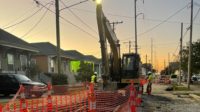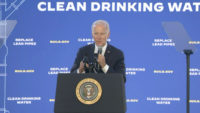A $477 million Environmental Protection Agency loan will help advance water infrastructure projects in Virginia’s Hampton Roads region.
The low-interest loan, given under the Water Infrastructure Finance and Innovation Act (WIFIA) and announced Sept. 10, is the second piece of $1 billion in assistance the EPA is providing to the Hampton Roads Sanitation District (HRSD) as the local agency works to replenish the Potomac Aquifer, address rising sea levels and help protect the Chesapeake Bay.
The money will support HRSD’s Sustainable Water Initiative for Tomorrow (SWIFT) program, with about half going toward new projects that will reduce nutrients and sediment released into waterways. The second half of the funds will go toward ongoing work building “full-scale SWIFT facilities” that return clean water to the aquifer.
In order to reduce the amount of sediment discharged into the James River basin, the agency plans to close the 80-year-old Boat Harbor Treatment Plant and replace it with a new pumping station. Officials expect that project will cost $65 million.
The pumping station will send wastewater about 4 miles across the river to another facility in Nansemond for treatment before that water is discharged. Local officials said “a significant portion” of water treated at Nansemond will meet drinking water standards under SWIFT, allowing it to be returned to the aquifer instead of the river as it would have been before.
If the projects work as planned, SWIFT will eventually reduce HRSD’s wastewater discharges into the Chesapeake Bay watershed by 90%.
Replenishing the aquifer has benefits beyond boosting the local water supply, according to HRSD. Having the aquifer filled can stop subsidence caused by water withdrawal, in turn helping protect coastal communities against rising seas.
To connect the two facilities on opposite sides of the river, HRSD is planning to install a 22,800-ft-long, 36-in-dia pipe under the James River at an estimated cost of $65 million, and 11,000 ft of 32-in dia pipe connecting to the aquifer recharge wells for another $20 million.
AECOM’s Norfolk, Va., office is serving as engineering consultant on the projects.
Work on the pump station conversion and underwater pipe installation is slated to start in the fall of 2022. Some final design work and property acquisition still needs to be done before the projects go out to bid. To meet regulatory requirements, the current Boat Harbor facility will need to be closed by the end of 2025.
Ted Henifin, general manager of HRSD, said the low-interest WIFIA loan will reduce the agency’s costs for the projects by close to $500 million over 30 years.
“It’s all pretty amazing investments by our region for the future, solving multiple problems,” he said.
WIFIA was established in 2014 with the goal of accelerating investment in water infrastructure across the U.S. To date, EPA officials said the program has announced 58 loans totaling $11.2 billion in credit assistance for projects worth $24 billion and creating 68,000 jobs in the process.






Post a comment to this article
Report Abusive Comment